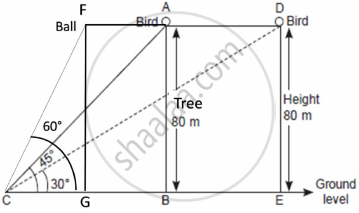Advertisements
Advertisements
प्रश्न
A person standing on the bank of river observes that the angle of elevation of the top of a tree standing on the opposite bank is 60°. When he moves 40 m away from the bank, he finds the angle of elevation to be 30°. Find the height of the tree and width of the river. `(sqrt 3=1.73)`
उत्तर १
Let AB = height of the tower = h metres
In the right angled ΔABC and right angled ΔABD,
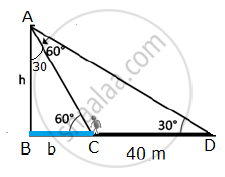
`tan60^@=h/(BC)=sqrt(3) rArr BC=h/sqrt(3)`
`tan30^@=h/(BD)=1/sqrt(3) rArr BD=hsqrt(3)`
`Now, BD – BC = 40`
`hsqrt(3)-h/sqrt(3)=40`
`(3h-h)/sqrt3=40`
`2h=40sqrt3`
`h=20sqrt3 m`
In right angled ΔABC,
`tan30°=1/sqrt3`
`(BC)/h=1/sqrt3`
`(BC)/(20sqrt3)=1/sqrt3`
`BC=b=20m`
Width of the river = BC = 20 m
Thus, the height of the tree is `20 sqrt3` metres and width of the river is 20 metres.
उत्तर २
Let BC be the height of the tree.
AB be the breadth of the river.
A be the initial position of the person
D be the final position of the person
∠CAB = 60° & ∠CDB = 30° & DA = 40m
Let AB = x & BC = h
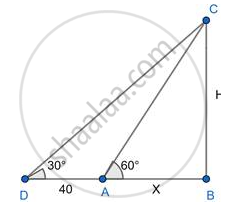
In Δ DBC
⇒ `tan 30 = "BC"/"DB" = "BC"/"DA+AB" ="h"/(40+"x")`
⇒ `1/sqrt3 = "h"/(40+"x")`
⇒ `"h" = 40+"x"/sqrt3` ................(1)
In Δ ABC
⇒ `tan60 = "BC"/"AB"="h"/"x"`
⇒ `sqrt3 = "h"/"x"`
⇒ `"h"=sqrt3 "x"` ..................(2)
Using (1) & (2)
`"h"=(40+"x")/sqrt3`
⇒ `sqrt(3"x")=(40+"x")/sqrt3`
⇒ 3x =40 + x
⇒ 2x = 40
⇒ x = 20
⇒ AB = 20m
⇒ BC = `20sqrt3` m =20 ×1.73 =34.6m
∴ Height of the tree is 34.6m and the width of the river is 20m.
उत्तर ३
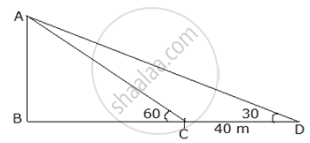
Consider the above diagram where AB is the height of a tree with point A as the top of the tree
Point B base of the tree
Initially, the person is at point C, therefore, BC is the width of the river and the person observes the angle of elevation to be 60° i.e. ∠ACB = 60°
The person moves 40 m away from the bank of the rives thus the new position of the person is point D and CD = 40m
From D the person observes the angle of elevation to be 30° i.e. ∠ADB = 30°
Consider ∆ABC
tan60° = `"AB"/"BC"`
∴AB = `"BC"sqrt3` …(i)
Consider ∆ABD
tan30° = `"AB"/"BD"`
`1/sqrt(3) = "AB"/("BC + CD")`
Using CD = 40 m
(BC + 40) = `"AB"sqrt3`
∴ AB = `("BC" + 40)/sqrt3` …(ii)
From (i) and (ii)
`"BC"sqrt3` = `("BC" + 40)/sqrt3`
∴ `"BC"sqrt(3) xx sqrt(3) = "BC" + 40`
∴ 3BC = BC + 40
∴ 2BC = 40
∴ BC = 20 m
Therefore width of the river = BC = 20 m
Substituting BC in equation (i)
AB = `20sqrt3`
∴ AB = 20 × 1.73
∴ AB = 34.6 m
Therefore height of tree = AB = 34.6 m
Hence height of tree is 34.6 meters and width of river is 20 meters
संबंधित प्रश्न
A passenger, while boarding the plane, slipped form the stairs and got hurt. The pilot took the passenger in the emergency clinic at the airport for treatment. Due to this, the plane got delayed by half an hour. To reach the destination 1500 km away in time, so that the passengers could catch the connecting flight, the speed of the plane was increased by 250 km/hour than the usual speed. Find the usual speed of the plane
What value is depicted in this question?
The angles of elevation and depression of the top and the bottom of a tower from the top of a building, 60 m high, are 30° and 60° respectively. Find the difference between the heights of the building and the tower and the distance between them.
A balloon is connected to a meteorological station by a cable of length 200 m, inclined at 60º to the horizontal. Find the height of the balloon from the ground. Assume that there is no slack in the cable
When the sun is 30º above the horizontal, Find the length of shadow cast by a building 50m high
From a point on the ground, the angles of elevation of the bottom and the top of a transmission tower fixed at the top of a 20 m high building are 45° and 60° respectively. Find the height of the tower. (Use `sqrt3` = 1.73)
A straight highway leads to the foot of a tower. A man standing at the top of the tower observes a car as an angle of depression of 30°, which is approaching the foot of the tower with a uniform speed. Six seconds later, the angle of depression of the car is found to be 60°. Find the time taken by the car to reach the foot of the tower from this point.
A person observed the angle of elevation of the top of a tower as 30°. He walked 50 m towards the foot of the tower along level ground and found the angle of elevation of the top of the tower as 60°. Find the height of the tower.
Find the angle of elevation of the sum (sun's altitude) when the length of the shadow of a vertical pole is equal to its height.
If the angle of elevation of a cloud from a point h meters above a lake is a and the angle of depression of its reflection in the lake be b, prove that the distance of the cloud from the point of observation is `(2h sec alpha)/(tan beta - tan alpha)`
A tower subtends an angle 𝛼 at a point A in the plane of its base and the angle if depression of the foot of the tower at a point b metres just above A is β. Prove that the height of the tower is b tan α cot β
Two boats approach a lighthouse in mid-sea from opposite directions. The angles of elevation of the top of the lighthouse from two boats are 30° and 45° respectively. If the distance between two boats is 100 m, find the height of the lighthouse.
An observer, 1.7 m tall, is 203–√203 m away from a tower. The angle of elevation from the of observer to the top of tower is 30°. Find the height of tower ?
If the height of a vertical pole is 3–√3 times the length of its shadow on the ground, then the angle of elevation of the Sun at that time is
(A) 30°
(B) 60°
(C) 45°
(D) 75°
The angle of elevation of the top of a hill at the foot of a tower is 60° and the angle of depression from the top of the tower to the foot of the hill is 30°. If the tower is 50 m high, find the height of the hill ?
Two buildings are facing each other on a road of width 12 metre. From the top of the first building, which is 10 metre high, the angle of elevation of the top of the second is found to be 60°. What is the height of the second building ?
Three villagers A, B and C can see each other using telescope across a valley. The horizontal distance between A and B is 8 km and the horizontal distance between B and C is 12 km. The angle of depression of B from A is 20° and the angle of elevation of C from B is 30°. Calculate the vertical height between A and B. (tan 20° = 0.3640, `sqrt3` = 1.732)
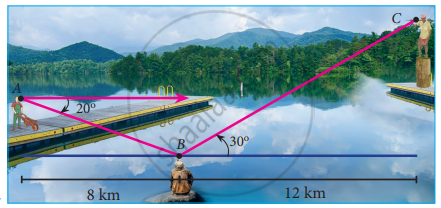
A bird is flying from A towards B at an angle of 35°, a point 30 km away from A. At B it changes its course of flight and heads towards C on a bearing of 48° and distance 32 km away. How far is C to the East of B?
(sin 55° = 0.8192, cos 55° = 0.5736, sin 42° = 0.6691, cos 42° = 0.7431)
An observer 1.5 metres tall is 20.5 metres away from a tower 22 metres high. Determine the angle of elevation of the top of the tower from the eye of the observer.
A straight highway leads to the foot of a tower. A man standing on the top of the 75 m high tower observes two cars at angles of depression of 30° and 60°, which are approaching the foot of the tower. If one car is exactly behind the other on the same side of the tower, find the distance between the two cars. (use `sqrt(3)` = 1.73)
|
One evening, Kaushik was in a park. Children were playing cricket. Birds were singing on a nearby tree of height 80m. He observed a bird on the tree at an angle of elevation of 45°. When a sixer was hit, a ball flew through the tree frightening the bird to fly away. In 2 seconds, he observed the bird flying at the same height at an angle of elevation of 30° and the ball flying towards him at the same height at an angle of elevation of 60°.
|
- At what distance from the foot of the tree was he observing the bird sitting on the tree?
- How far did the bird fly in the mentioned time?
(or)
After hitting the tree, how far did the ball travel in the sky when Kaushik saw the ball? - What is the speed of the bird in m/min if it had flown `20(sqrt3 + 1) m`?
